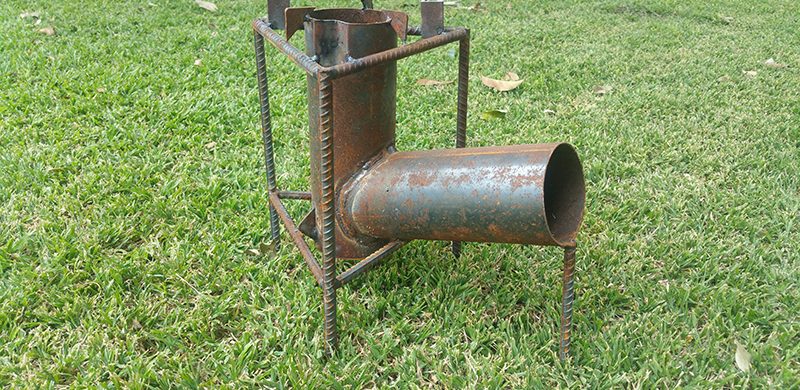

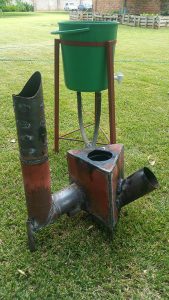
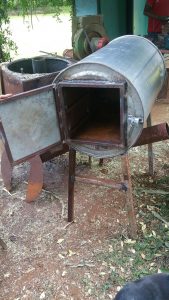
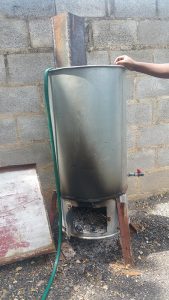
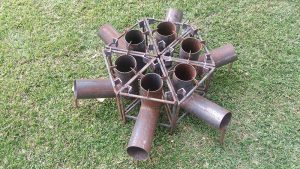
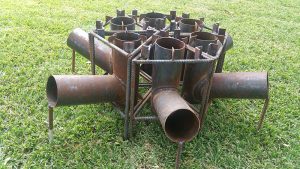
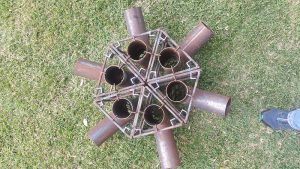
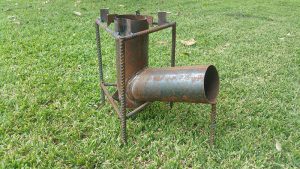
Last week Wednesday, the I4A team went to Lance Edwards’ house to investigate and inquire more about the utilities he has come up with to alleviate Africa’s problems. Lance Edwards has a BSc in Environmental Science & Chemistry. For the last 20 years, Lance has worked in research and development to bring appropriate technologies to small scale farmers and the rural poor in Africa.
Among the devices and gizmos, we have a water heater, rocket stove, oven as well as the various combinations and uses for the rocket stove. The rocket stove is not a new phenomenon as there are quite a few variations already available on the market. What is interesting about what Lance is making is the fact that he has gone further to harness energy already at disposal for water heating.
The water heating rocket stove he has come up with has 2 water tubes coming out of it. The stove is then able to heat up your water in a separate bucket which will be attached to the stove through the tubes, whilst you cook. In 30 mins, the heat produced by the stove can reach up to 90℃. The downside of this innovation is that you must keep constant watch of the stove as you cook to monitor and make sure the heat supplied is constant.
The purpose of the rocket stove is to minimize the cutting down of trees as the rocket stove require a small amount of firewood. Firewood can be substituted by centana, maize cobs, sawdust, briquets, biochar, cardboard as well as homemade alcohol.
The rocket stoves present the idea of sustainable harvest in that resources can be used in such a way that they are not depleted and that they are replaced. For instance, planting trees after cutting down others to keep the ecosystem balanced. Sustainable harvesting is harvesting that allows population numbers to be maintained or to increase over time. It also alleviates a health hazard and risk as less smoke is emitted as cooking and water heating take less time. In addition, it takes less time to cook food as the stove itself reaches high temperatures. This, however means that you must keep constant guard of the stove and ensure that kids do not play close to the stove.
We also have a double jacket rocket stove, which is made up of 2 layers of the metal sheeting used to make the stove. This development enables more heat to be trapped and therefore increases efficiency of the stove and translates to less time taken to cook a meal.
He showed us an oven which is completely sealed off and is ideal for baking cookies and cakes and has been sold to a handful of customers. The oven reaches temperatures around the 500℉ mark. The only con to this is that it needs a chimney and may need to be improved on to increase efficiency by possibly insulating it or by other means.
Finally, we were presented with a water heater. The water heater has a capacity of ±150l. It heated at a rate of 10℃ at an interval of 5 minutes. The water heater comprises of 3 heat cylinders. The heater takes 1 minute 5 seconds to start heating up. In 30 minutes, it reaches temperatures of up to 100℃. What currently makes it efficient is the fact that the smoke that moves through the cylinders and out of the chimney causes increased heat. However, this causes a hazard to the environment as the it emits a lot of carbon. There may need to be a probe into what better potential accelerants can be used to heat up the water. Currently, firewood and grease are being used to start the fire.
There is a full set available which includes a water distiller, a water purifier, and a sterilizer for medical equipment. It also has attachments, such as a stove, a fryer, and an iron. Most of these products would be ideal in a rural or peri urban setting.
In light of this, the community interest brought out by the rocket stoves and the other innovative products is that it would reduce the vulnerability of women in rural settings who succumb to sexual abuse as they look for firewood and face the risk of being attacked by snakes and other animals out in the wild. According to Rainforest Action Network (RAN), 3.5 billion to 7 billion trees are cut down per year worldwide. Women cooked in pots heated up with firewood at an Internally Displaced Persons (IDP) camp at Dikwa in Borno State, north-eastern Nigeria, in February 2016, after Boko Haram attacks. This meant that women could not be able to get firewood as freely as they used to and had to resort to moving in packs in order to get firewood to cook but with the rocket stoves they could cook communally and be able to use less firewood than usual. In an article written by NewsDeeply in 2017, “As an example of the everyday difficulties that families in Mundri, (South Sudan) are facing, Ana Henry (WEP) points to the seemingly simple errand of collecting firewood. “Women are now sent to get the firewood,” she says. “They’ll get raped. But if their husbands go, they’ll get killed. So between rape and murder, which one is better?”
How can the rocket stoves be made more efficient so that less women in the rural and peri urban centres of Africa are less prone to threats of rape and assault? What can be introduced into the innovative products by Lance to alleviate health hazards and attacks on African women? Perhaps this is a discussion which could be had with NUST and UZ students on how they make them more efficient and user -friendly and possibly cheaper to make and acquire





